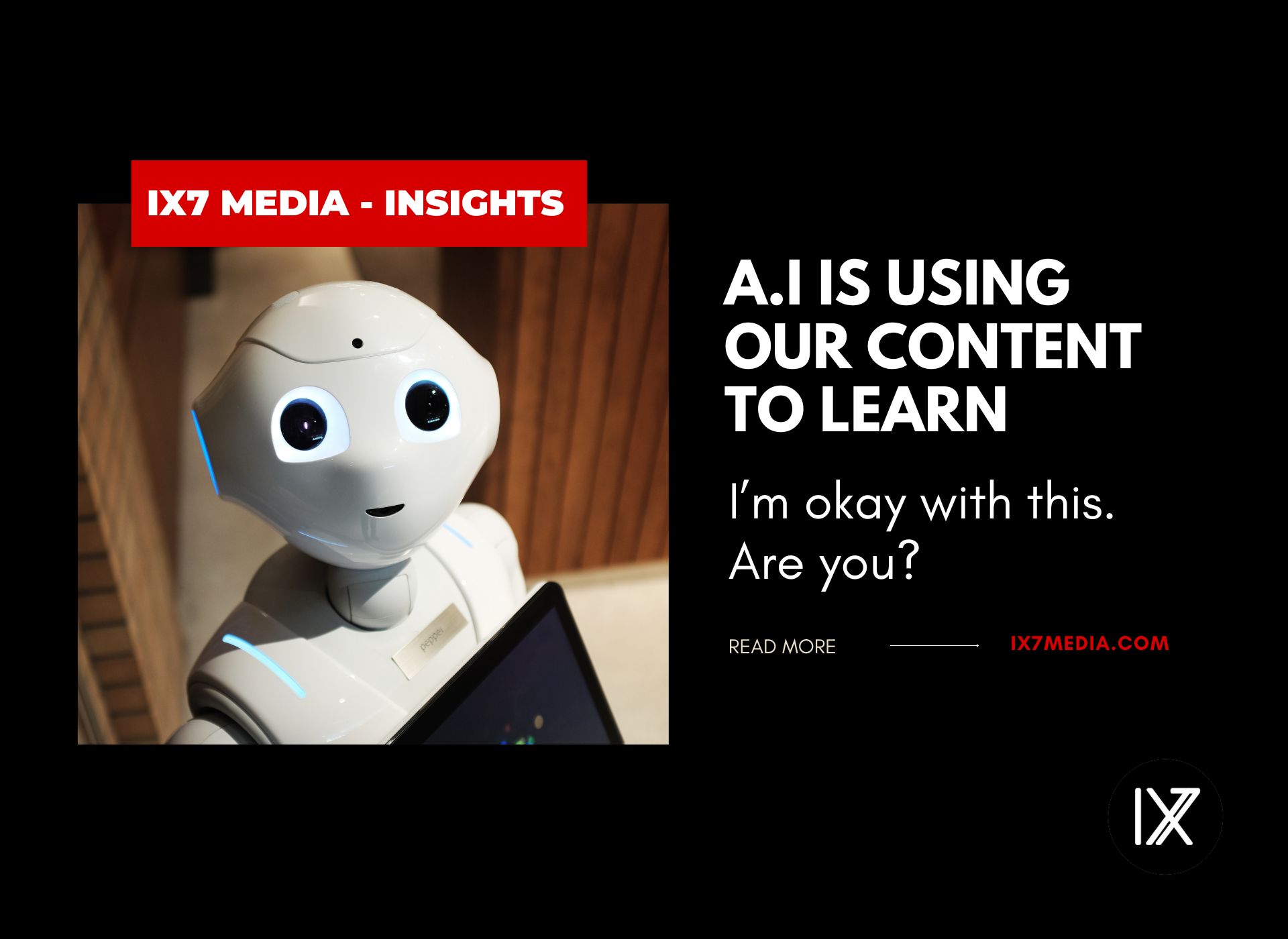
21 Oct Artificial Intelligence is learning from us, and I’m okay with that
Artificial intelligence (AI) is reshaping industries and our personal data has become an essential ingredient in this growth with large corporations using our behaviour to train their artificial intelligence algorithms. From social media platforms to search engines, AI is constantly learning from our interactions, our preferences, and now our content to improve natural language processing and the relevance of replies.
Recently, a growing number of companies have been transparent about how they use user data to train their AI systems, sparking conversations around privacy, consent, and the ethical use of data. If AI is learning from us every day, it’s crucial to understand what this means for our online presence and digital privacy and ask…am I okay with this? But, let’s be honest: if you’re going to ask if I’m okay with this, you’ve also got to consider the convenience this machine learning brings.
Ethics vs. convenience:
AI brings incredible convenience to our daily lives, often in ways we don’t even realise. From personalised shopping experiences to smart assistants, AI helps make routine tasks more efficient and tailored to our needs. For example, loyalty programs like Tesco’s Clubcard use AI to track our most common purchases, analyse buying patterns, and send targeted discount coupons based on what we’re most likely to buy. Similarly, streaming services like Netflix recommend shows based on your viewing history, while smart speakers like Amazon Alexa and Google Assistant help with everything from setting reminders to controlling smart home devices. Even the predictive text on your phone, which suggests words as you type, is powered by AI learning from your past inputs. Whether you’re ordering groceries, navigating with Google Maps, or scrolling through your social media feed, AI is quietly working behind the scenes to simplify your day-to-day life. Would you give this up? Well, let’s look at how your content, behaviours and preferences are being used to give you a full picture of how big tech is using your data to train its artificial intelligence algorithms.
X (Formerly Twitter): The Latest in AI Training Transparency
In October 2024, X (formerly Twitter) made waves by updating its Terms of Service to explicitly state that it uses user-generated content, including tweets, posts, and interactions, to train AI models. This isn’t just for developing its in-house AI chatbot Grok but extends to other machine learning efforts.
Effectively, this means that everything you tweet or comment on is being used as data to enhance the AI systems of X. These systems learn from patterns in human interaction, language nuances, and even your emotions. While users within the European Union are protected under the General Data Protection Regulation (GDPR) and are not subject to these changes, users in other regions must either agree to the new terms or stop using the platform. While you can opt out of having your interactions with Grok included, the rest of your content is still fair game for AI training.
But X is not alone in this. Major platforms have been leveraging user data for AI training for years, though many haven’t made their methods as explicit as X recently has.
Meta (Facebook and Instagram): The Silent Learner
Meta, the parent company of Facebook and Instagram, has long been utilising user data to train its AI systems. Every interaction you make—whether liking a post, commenting, or scrolling past certain content—is recorded and analysed to build more powerful machine learning algorithms. This is why your feed feels so personalised and how the platform gets better at recommending content you didn’t even know you wanted to see.
Recently, Meta’s AI efforts have taken a leap forward with LLaMA (Large Language Model Meta AI), its own AI model designed to compete with OpenAI’s ChatGPT. Meta uses vast amounts of user data to help train this AI, allowing it to improve conversational abilities and prediction models. But despite its sophistication, users have limited control over what data is being harvested, and the lines between necessary data collection for platform improvements and invasions of privacy are becoming harder to define.
Google: From Search to AI Training
Google, one of the biggest data collectors in the world, uses your search history, emails (if you’re using Gmail), and other interactions across its ecosystem to fuel AI advancements. Google’s AI systems, including Google Assistant and its language models, are trained using anonymised data collected from millions of users worldwide.
Through AI models like BERT (Bidirectional Encoder Representations from Transformers) and PaLM (Pathways Language Model), Google continuously improves its natural language processing and understanding by learning from the billions of queries users input into its search engine every day. Google Maps, YouTube, and even Google Photos contribute to the company’s massive AI training efforts, as user actions provide the training data necessary to enhance services like predictive search results, content suggestions, and personalised experiences.

Interestingly, Google recently introduced more visible privacy controls, allowing users to see what data is being collected and offering limited ways to manage what’s shared. However, even with these controls, much of the data collection necessary for AI training happens behind the scenes, and users often unknowingly contribute to the improvement of these models.
OpenAI (ChatGPT): Public Contributions to AI
OpenAI, the organization behind ChatGPT, is another entity where user data plays a massive role in training its models. ChatGPT, in particular, has learned from a vast array of public data sources, including websites, books, and user interactions. When you use ChatGPT, each conversation feeds into a feedback loop that allows the model to better understand language patterns, improve responses, and refine conversational logic.
Though OpenAI does not explicitly use private conversations for model training by default, users can opt into contributing their conversations to help improve future iterations of the AI. This has raised questions around the ethics of data use in AI training, as many users are unaware of how much they’re contributing simply by using such tools.
TikTok: AI and the Content Loop
TikTok, a favourite among Gen Z, relies heavily on AI to curate its “For You” page, which is a core part of its addictive user experience. The platform uses a combination of deep learning algorithms and data points from user interactions, including video likes, shares, comments, and time spent watching videos, to train its AI models.
The result is a highly personalised feed that learns from your preferences in real-time. While this provides an engaging experience, TikTok’s use of data for AI training raises concerns about how much personal information is used and to what extent it is shared with third-party partners. With its complex algorithm, TikTok collects and analyses more data points than many other social platforms, providing a goldmine of information to fuel its AI advancements.
Are We Truly in Control?
With so many platforms collecting vast amounts of data to train AI systems, one thing is clear: we’re not fully in control of how our data is being used. While platforms like X and OpenAI are beginning to openly state their use of content for AI training, many companies still operate in a grey area when it comes to transparency.
The ethical implications are vast. Should users have the right to opt out of all data collection for AI training? Should companies provide clearer guidelines on how data is being used? And most importantly, are we, as users, comfortable with our online interactions fueling the next generation of AI?

The Path Forward: Awareness and Action
As AI continues to evolve, it’s critical for users to be more aware of the role they play in its development. Understanding the trade-offs between privacy and convenience can help individuals make more informed decisions about the platforms they engage with.
Whether you’re using X, Facebook, Google, or TikTok, it’s essential to stay updated on how these companies are handling your data. We may not always be able to control how our information is used, but we can advocate for better transparency and more robust privacy protections.
At IX7 Media, we are committed to exploring the intersection of technology and ethics, helping businesses and individuals navigate the digital landscape with clarity. Reach out to us for more insights and to ensure your digital strategies align with both your values and goals.



